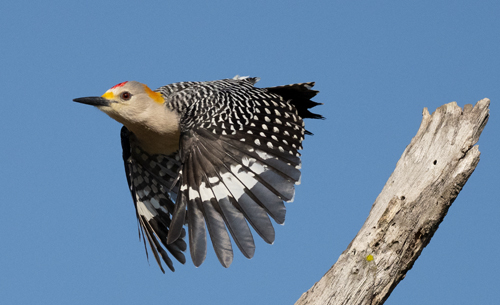
Golden-fronted Woodpecker,
South Texas Photo Tour
Switching to Olympus
Part 2
ProCapture
The Game Changer
and some examples of AF, too!
The images and some of the text (with new additions explaining the shots, however) that follows are excerpted from our 2019 Texas and Arizona Photo Shootsand from my most recent shoot in coastal New Jersey. Although we won't be doing our Arizona Hummingbird Photo Shoots in the foreseeable future, we will be returning to Texas in 2021 for more bird and wildlife photography. Just so you know.
In this text I'll explain the best procedures for using ProCapture - so keep reading!
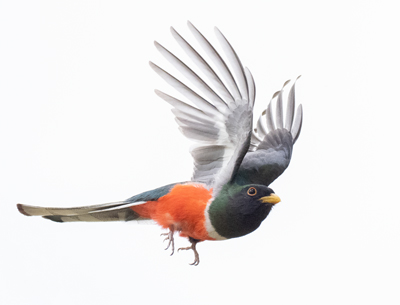
Elegant Trogan,
Santa Rita Mts - Arizona Hummingbirds and Bats Photo tour
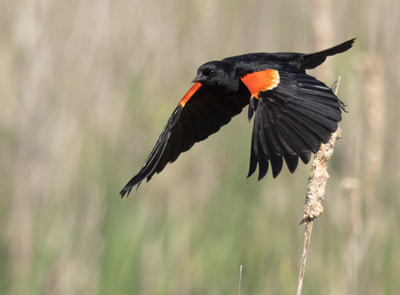
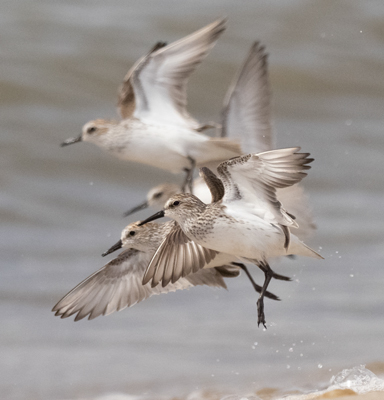
Red-winged Blackbird and Semipalmated Sandpipers,
Coastal NJ
Since Mary and I have switched to Olympus we really hadn't had a great chance to use ProCapture, the absolute game-changer for action photography. Our shoots at both ranches on our most recent photo tours changed that, and we had multiple opportunities to catch birds in flight, revealing poses we'd have missed with traditional gear. ProCapture, with the flagship M1X camera, records 35 frames prior to the frame where the camera actually fires, doing so in a loop that continually rewrites over the 35th frame as the newest frame is recorded. Images are not written to the SD card until you actually fire off a shot, so you're not eating up SD card memory. The result, instead of having the tail-end of a bird or nothing at all in the frame, we were recording the entire take-off, picking the shot that best illustrated the behavior. The OM D E Mark II, Olympus's previous flagship camera, records 14 frames, instead of 35, but is a very affordable alternative that still produces magic images via ProCapture.
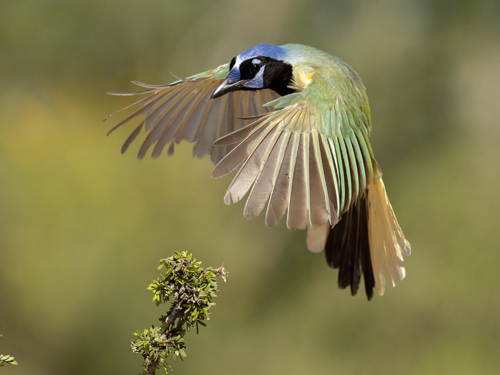
Green Jay
The key to ProCapture is timing. With my old system (Canon), Mary and I would have to anticipate and hope that we'd fire just as a bird lifted, and that we'd catch it in the frame. That rarely happened, as the bird still flew out of the frame.
With ProCapture, we're firing as the bird launches, but we're not worried about 'anticipating,' but instead we're just reacting when the bird flies. Actually, with slower-moving birds, like hawks and eagles, it's best to almost hesitate a moment, which provides time for the bird to actually travel some distance, and thus giving you more frames of the bird launching and flying. With songbirds, however, a fast reaction time is prudent -- these subjects move fast!
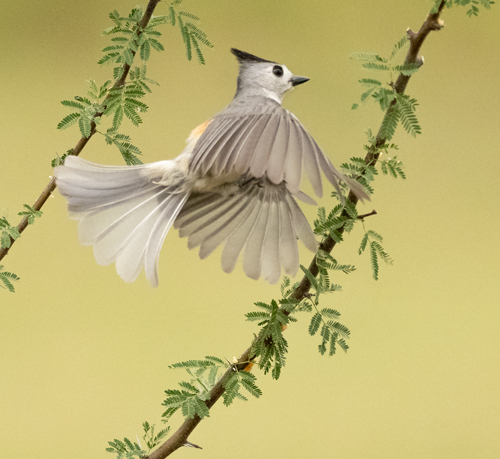
Black-crested Titmouse
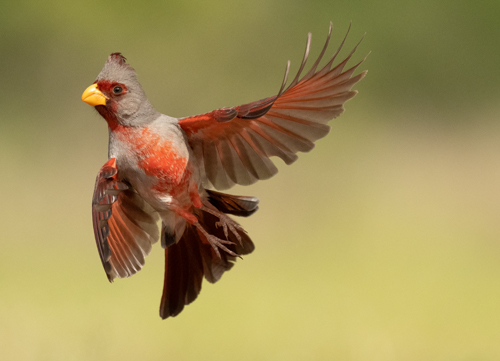
Pyrrhuloxia
ProCapture uses the electronic shutter, rather than the mechanical shutter that tops off at 1/8,000th sec. The electronic shutter goes to 1/32,000th sec, which equals the flash duration in high speed flash setups. Fast shutter speeds require bright light, and high ISOs. Most of my ProCaptures were made at IS) 3200. But the Blue Grosbeak, below, was shot at ISO 6400 at 1/5000th second, in overcast light.
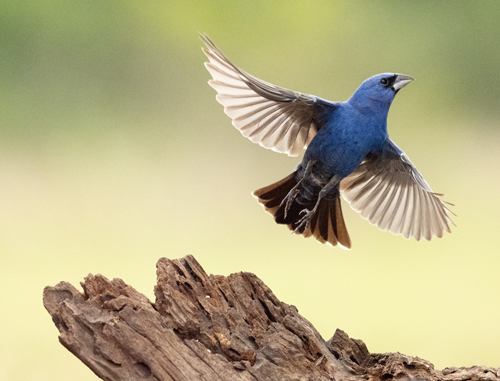
Blue Grosbeak
Here's an enlargement and below, the full-frame capture. The original capture was slightly underexposed, so I increased the exposure slider. However, I did not apply any Sharpening, nor any Noise Reduction, to these images, so you can judge for yourself the 'noise' issue at ISO 6400. To me, it is negliable.
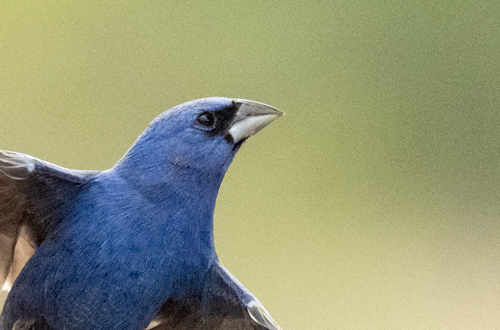
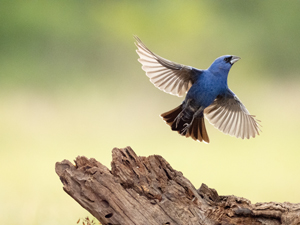
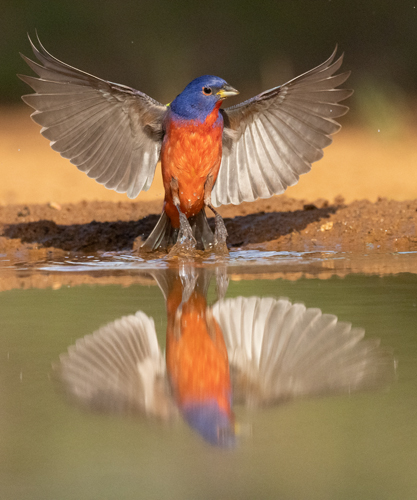
Painted Bunting
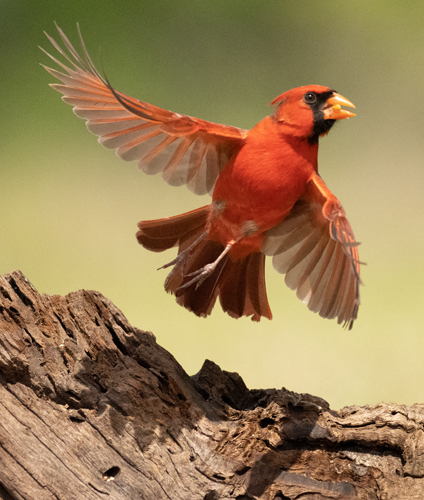
Northern Cardinal
We had fun with insects, too. I challenged a friend to capture this Dragonfly as it was about to land. Every time he fired, the Dragonfly was either perched or out-of-focus as it was still beyond the plane of focus. I was using ProCapture, and snapped as soon as the Dragonfly landed. The result, multiple images of the Dragonfly as it was about to land (it did this several times).
.jpg)
The most impressive demonstration of ProCapture, however, was with this flying Dragonfly. I only had one opportunity, as the Dragonflies were literally darting all around the pond, but once, one hovered long enough for me to acquire focus, and I fired. The image on the left is out-of-focus, as the camera's lag time, and my response, was too slow, and the insect had flown out-of-focus. However, with ProCapture, I had 35 prior frames, and I had 4 or 5 sharp images of the flying insect!
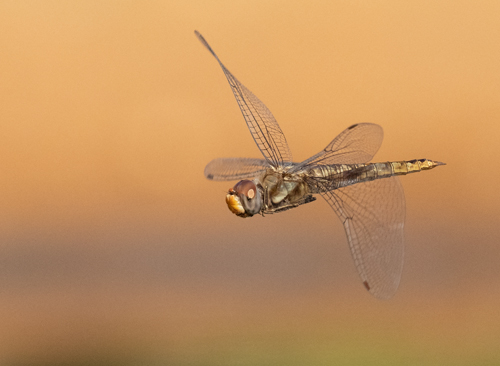
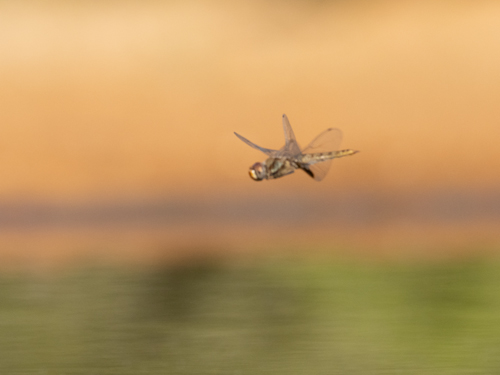
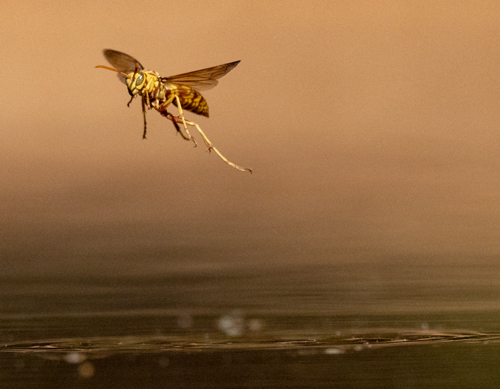
Hornets were floating on the pond, too, and would periodically launch in flight. Again, by the time anyone shot, the insect was out of the frame. However, with ProCapture, I caught the wasp on the water, and in the air, and when it remained in the plane of focus, I got several great shots.
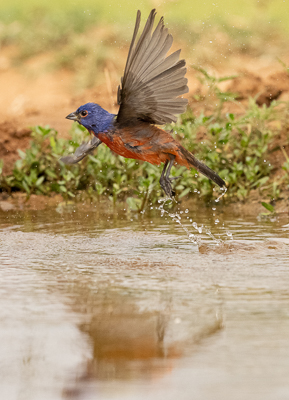
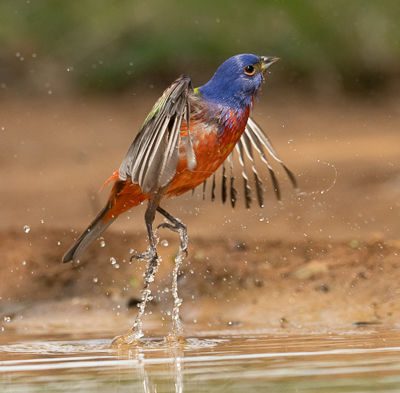
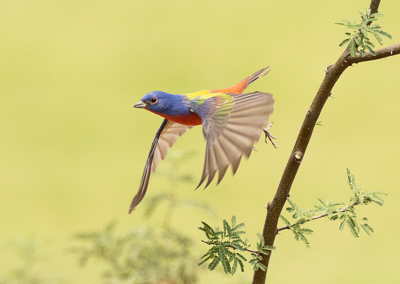
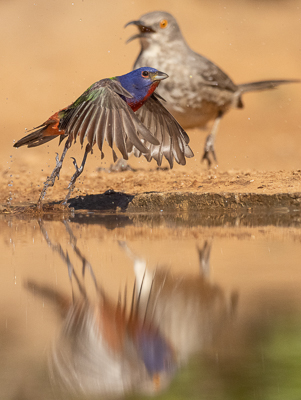
I can't say enough about ProCapture. The above Painted Buntings are just selects from several in a series for each of those images, meaning I'm picking a representative shot from a choice of many for each bird. I'd have been lucky to get one with my old gear, as one shooter on our trip proved, getting one shot -- flying away -- of a Painted Bunting! Here are more examples:
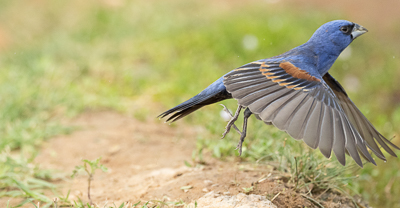
Blue Grosbeaks
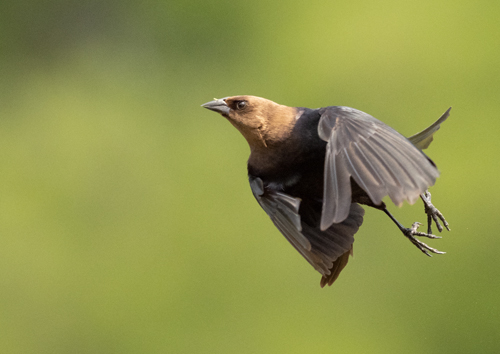
Who could imagine a Cowbird could make a beautiful shot?
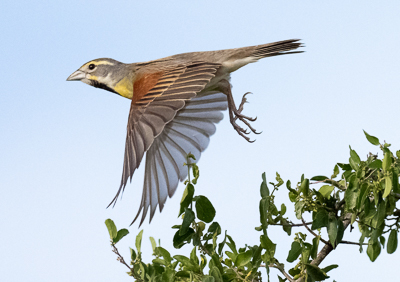
Dickissel
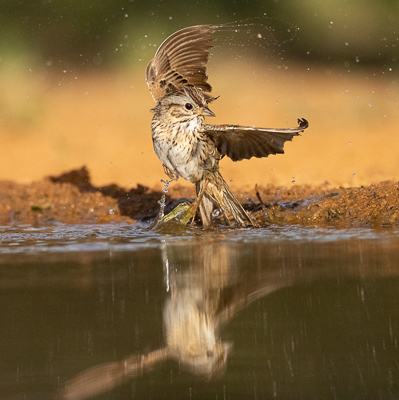
Lincoln Sparrow
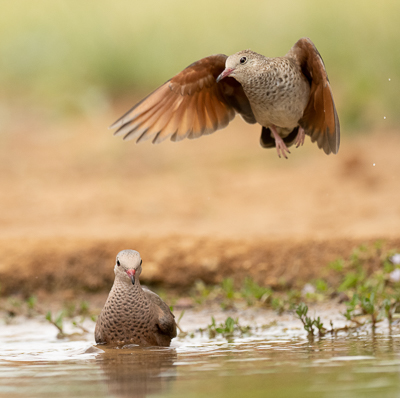
Ground Dove
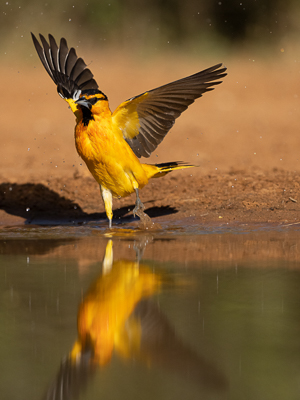
Bullock's Oriole - moments after flinching at a curious bee.
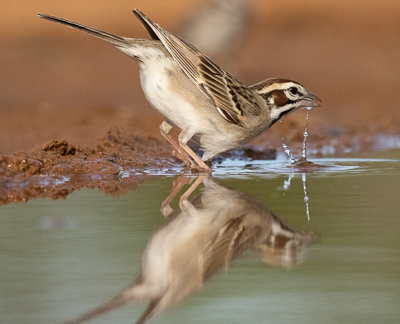
Lark Sparrow - even when not flying, ProCapture gave me plenty of images to choose from as this sparrow dipped and drank.
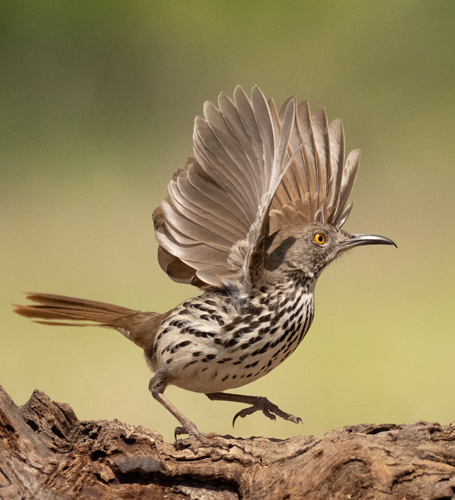
Long-billed Thrasher
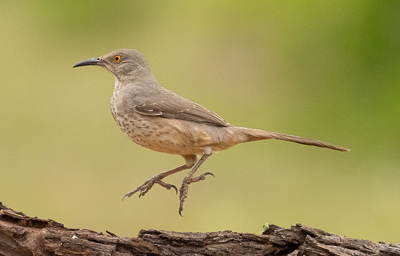
Curve-billed Thrasher - an ordinary pose suddenly turned magical, hopping along a log.
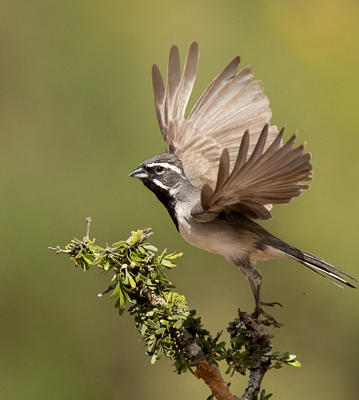
Black-throated Sparrow
Although we've been shooting Olympus for almost 9 months, our travels for Pumas, Tigers, Gorillas, etc., didn't involve taxing AF challenges. So I wasn't sure how well the cameras would perform for birds in flight. I discovered, as hoped, that the M1X did quite well. Here's some examples:
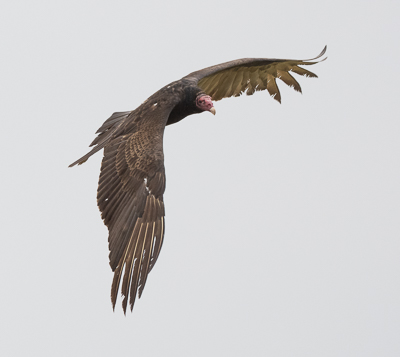
Turkey Vulture - not the fastest flier, but sharp.
We had numerous chances to photograph Crested Caracaras at both ranches at special blinds.
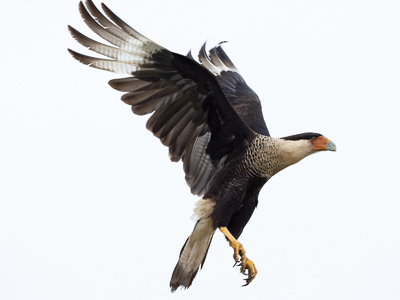
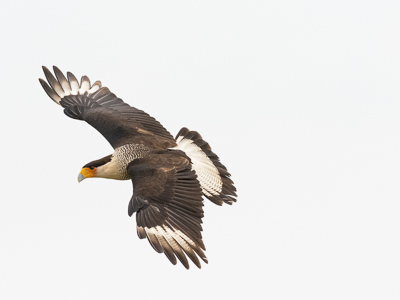
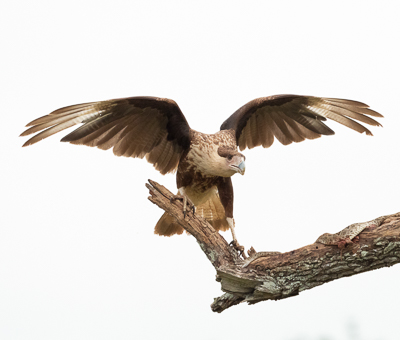
.jpg)
Focus held, despite a challenging background!
.jpg)
Crested Caracaras - these birds flew in much faster, and getting sharp shots of birds flying parallel was a no-brainer, but I was happy to see in-coming shots were mastered well, as well.
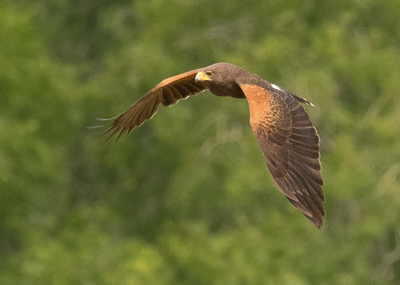
Harris Hawk - this is one of a series -- the bird was rather small in the frame and this is cropped, but the AF held focus throughout, despite a busy and potentially letal background. Subsequently, on other shoots I found AF worked equally well with busy backgrounds.
In New Jersey, just a few days ago, I further tested the AF - catching this Osprey as it flew passed as I was waiting on a Marsh Wren. I hand-held all of these shots, panning in each case at shutter speeds ranging from 1/4,000 to 1/6400th sec.
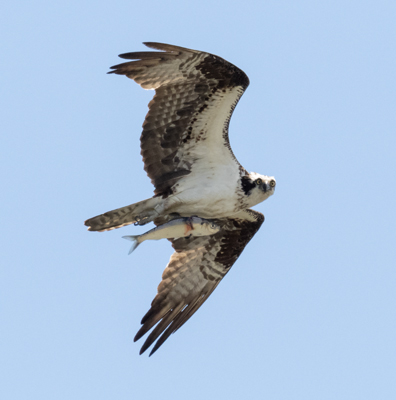
For this American Oystercatcher I had mere seconds to react as the bird flew passed. I got off 3 frames, 2 super sharp, 5 stars in my rating system, and the other 4 -- not bad!
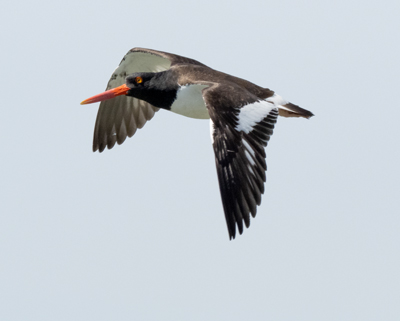
We had multiple passes with Black Skimmers, but the light was low and the birds were flying fast. I used a 9 spot cluster of AF points, and too frequently I didn't keep up with the pan. Consequently, between low light and bad photo technique, I didn't have great success -- maybe 60%, but I got a lot of keepers.
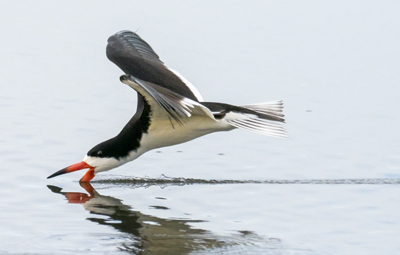
With ProCapture I shot Semipalmated Sandpipers as they launched into flight. The procedure was similar to the songbirds -- I focused on birds I expected would fly, and fired as soon as they did. Sandpipers are really fast, too, so I caught a lot of poses as they flew out of the frame.
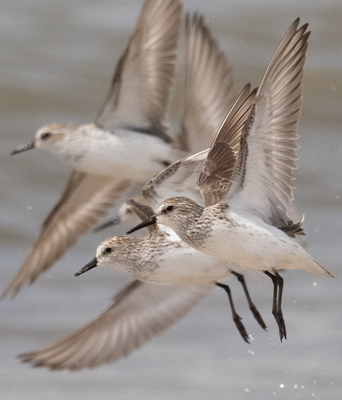
To catch a bird flying straight in, I focused on a spot amongst the birds, at approximately the distance I hoped in-coming birds would be flying in, and waited. As birds swooped in I'd fire, and sometimes my focusing distance guess was correct, and I'd get several in-focus, sharp images. You might argue that AF could or should do the same job, but the reality is these birds are flying in as fast as swallows, and coming in unexpectedly (at least if you're looking through your viewfinder), so ProCapture was the best method in my humble opinion.
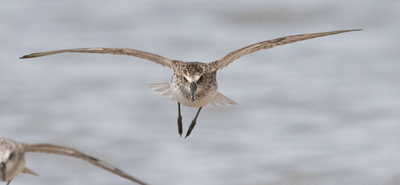
Back in Texas, we had a friendly contest to catch Kiskadee and Scissor-tailed Flycatchers around a pond. I wanted to catch a Scissor-tailed as it dipped into the water -- a nearly impossible task, considering the birds came out of nowhere and hit anywhere in the pond. Needless to say, I got shots no one else did -- and it wasn't my skill that was responsible!
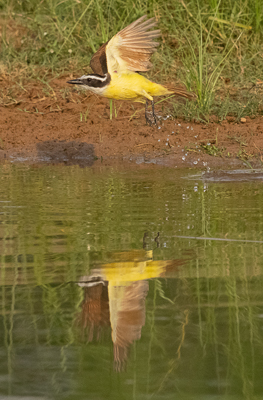
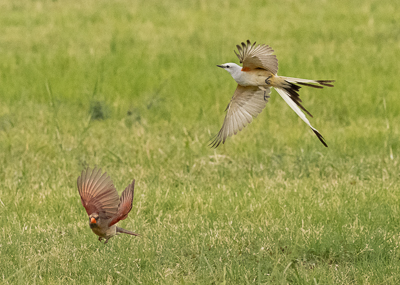
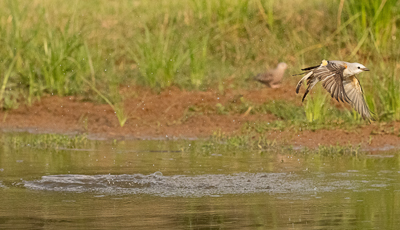
Depth of field is definitely increased over my full-frame cameras and here's a shot that really illustrates this. I was focused on the limb, using ProCapture, and when this rare Couch's Kingbird launched, it flew towards the camera. There are probably 8 inches between the bird's beak and the limb -- at f4, and everything is sharp! The image is cropped (so the bird was about 1/3 smaller in my full image), so DofF did increase, but still! And ... at 1/20,000th of a sec!
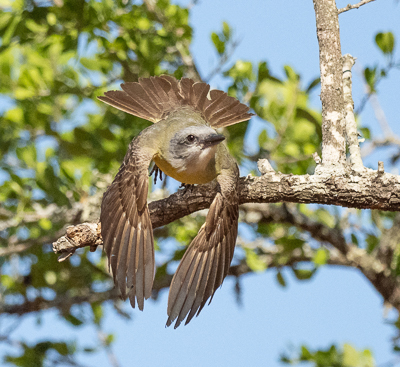
In Arizona we had another first -- another friend, Steve, informed us that a Northern Pigmy Owl was nesting in a tree only two hundred yards from our lodge. I visited it, met another old friend while there, and had my first opportunity to photograph a Pigmy Owl.
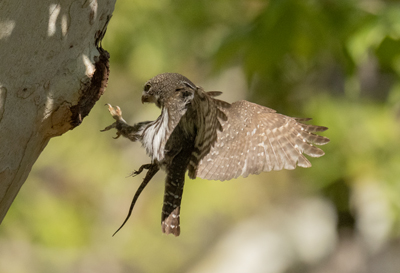
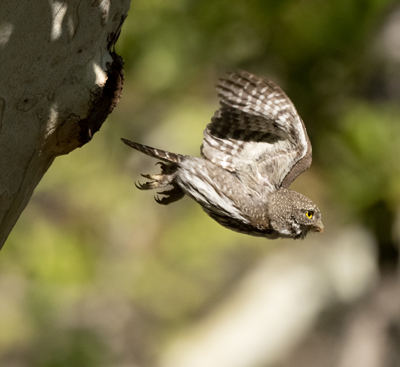
I wouldn't have got either of these shots without the Olympus M1X ProCapture feature. The owl practically rocketed into the nest hole, pausing only for a moment before disappearing inside. I had activated ProCapture and waited, as we'd heard the owl calling and we suspected it would fly in, and as it landed, I fired. The bird was inside the nest hole before human and camera lag time fired the camera, but with ProCapture, I also recorded the previous 35 frames, including the one, above, as the bird carried a lizard into the hole. A few minutes later, the owl exploded out of the nest hole, and again, ProCapture, caught the bird.
Several participants got great shots just sitting by our first Hummingbird station. I used (guess!) ProCapture to catch the Trogan in flight, catching unique images in the best photographic opportunity I've ever had for this bird.
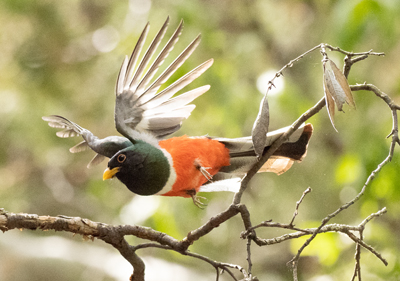
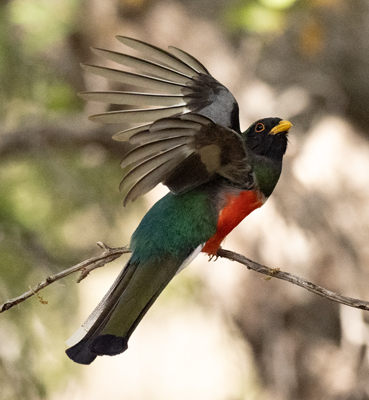
At our Number 4 Hummingbird set another Arizona bird trophy, a Painted Redstart, hunted the trees and underbrush close by.
This bird moved fast, pausing only for a moment before flitting off to the next branch. I was using the 300mm with a 1.4X tele-converter, equivalent to 840mm, so my angle of view was very narrow, and quickly locating the constantly moving bird was a challenge.
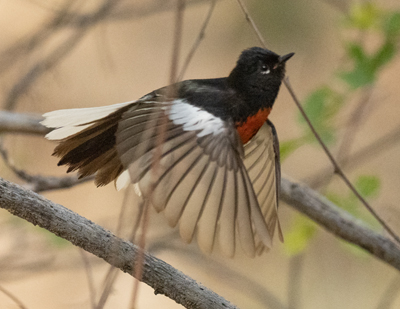
At The Pond, in Arizona, I kept on ProCapture to catch action, as you'll see.
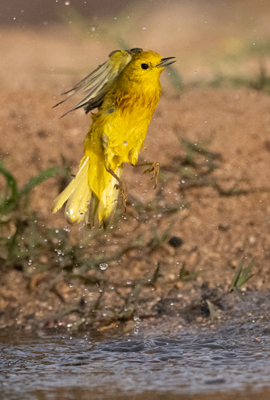
Yellow Warbler
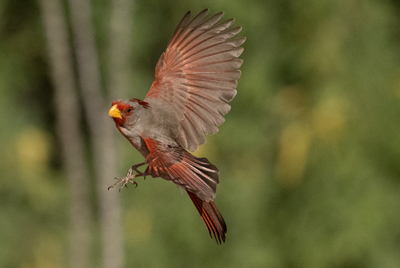
Pyrrhuloxia
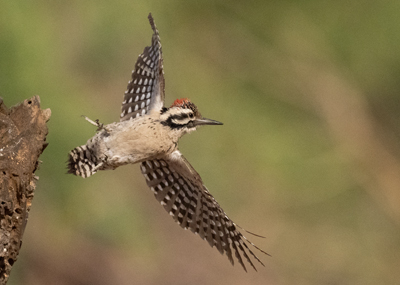
Ladder-backed Woodpecker
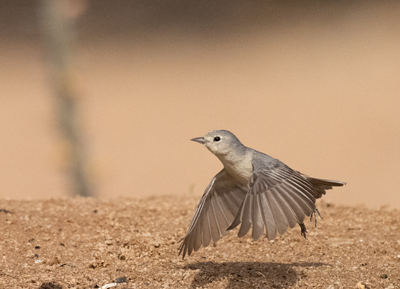
Lucy Warbler
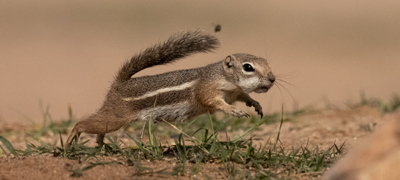
Harrisson Antelope Ground Squirrel - I was expecting the squirrel to spin and run, as it did after drinking. This one jumped parallel, and I caught several strides.
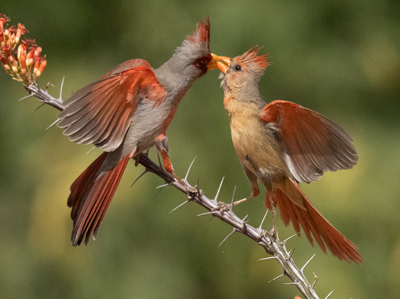
Pyrrhuloxia and Cardinal in a spat - not a kiss! I was on ProCapture but I didn't expect this interaction, I was expecting flight. When this spat occured I naturally reacted, and caught a whole series as the birds came together and then parted.
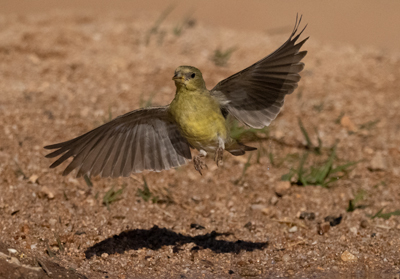
Lesser Goldfinch
As I mentioned above, for the mammals we photographed, I concentrated on Cottontails and Jackrabbits, and Ground Squirrels, that I expected to move, run, or jump. Naturally, when they did so and I fired, I was too late, but with ProCapture I caught the action. With the Cottontails, I caught some interesting poses as rabbits jumped over each other!
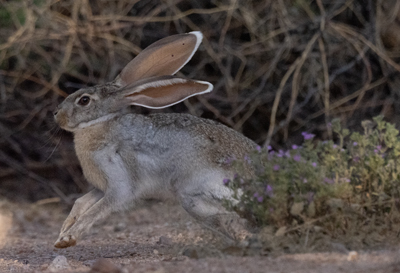
Using AF below, and following the Jackrabbit.
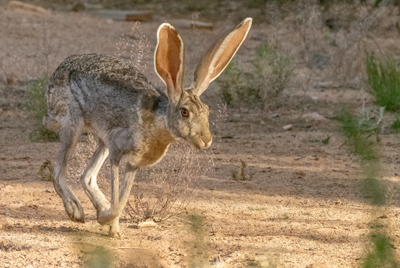
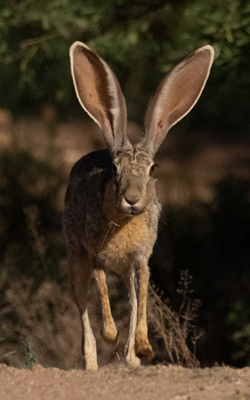
Antelope Jackrabbit
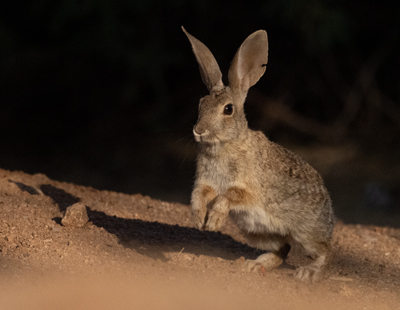
As this rabbit started running I fired.
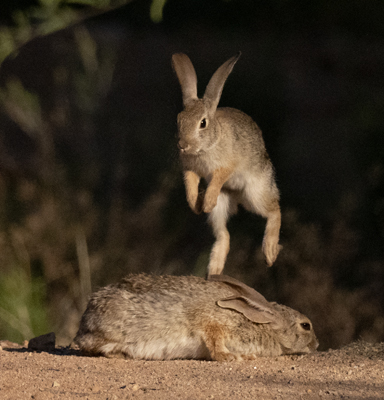
In play this Desert Cottontail hopped over another, and, below, another one just hopped straight up into the air, and back down in the same spot.
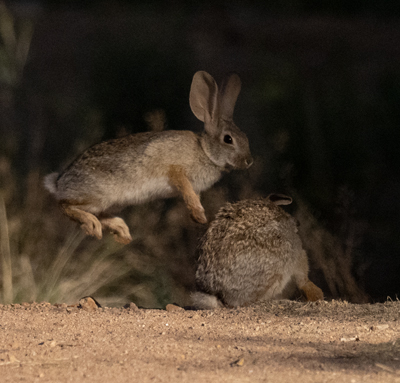
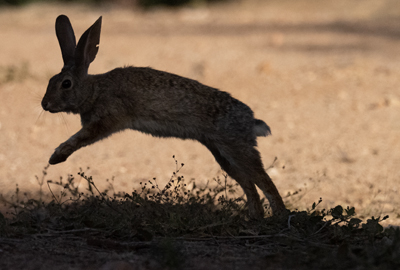
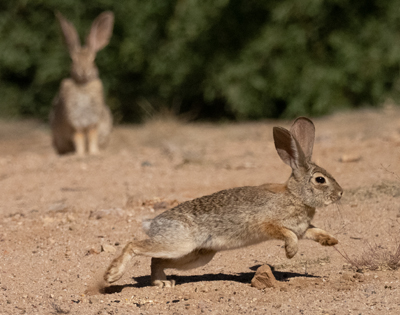
Desert Cottontail
Hopefully this will convince you that ProCapture is the game changer for wildlife action photography. The Olympus system offers much, much more, and I'll be providing write-ups and videos on this in the near future.
If you found this useful, and you're ready to switch, please click on the links below to the Olympus store. Honestly, if you buy from these links, we'll get some credit, but even if you don't -- make the switch, it's the best thing Mary and I have done for our photography since ... ever!
Check out the prices -
Olympus Official Store

Why you should travel with us
Testimonials
Featured on ShotKit - read the interview
Join us on Facebook at: Follow Hoot Hollow
Office Phone: (717) 543-6423
Or FAX us at: (717) 543-5342
Mary and Joe are proud to endorse the Photo Retailer that has
done the absolute most in supporting nature photography in all
its facets ---

Check out the Monthly Specials
from Hunt's

Golden-fronted Woodpecker,
South Texas Photo Tour
Switching to Olympus
Part 2
ProCapture
The Game Changer
and some examples of AF, too!
The images and some of the text (with new additions explaining the shots, however) that follows are excerpted from our 2019 Texas and Arizona Photo Shootsand from my most recent shoot in coastal New Jersey. Although we won't be doing our Arizona Hummingbird Photo Shoots in the foreseeable future, we will be returning to Texas in 2021 for more bird and wildlife photography. Just so you know.
In this text I'll explain the best procedures for using ProCapture - so keep reading!

Elegant Trogan,
Santa Rita Mts - Arizona Hummingbirds and Bats Photo tour


Red-winged Blackbird and Semipalmated Sandpipers,
Coastal NJ
Since Mary and I have switched to Olympus we really hadn't had a great chance to use ProCapture, the absolute game-changer for action photography. Our shoots at both ranches on our most recent photo tours changed that, and we had multiple opportunities to catch birds in flight, revealing poses we'd have missed with traditional gear. ProCapture, with the flagship M1X camera, records 35 frames prior to the frame where the camera actually fires, doing so in a loop that continually rewrites over the 35th frame as the newest frame is recorded. Images are not written to the SD card until you actually fire off a shot, so you're not eating up SD card memory. The result, instead of having the tail-end of a bird or nothing at all in the frame, we were recording the entire take-off, picking the shot that best illustrated the behavior. The OM D E Mark II, Olympus's previous flagship camera, records 14 frames, instead of 35, but is a very affordable alternative that still produces magic images via ProCapture.

Green Jay
The key to ProCapture is timing. With my old system (Canon), Mary and I would have to anticipate and hope that we'd fire just as a bird lifted, and that we'd catch it in the frame. That rarely happened, as the bird still flew out of the frame.
With ProCapture, we're firing as the bird launches, but we're not worried about 'anticipating,' but instead we're just reacting when the bird flies. Actually, with slower-moving birds, like hawks and eagles, it's best to almost hesitate a moment, which provides time for the bird to actually travel some distance, and thus giving you more frames of the bird launching and flying. With songbirds, however, a fast reaction time is prudent -- these subjects move fast!

Black-crested Titmouse

Pyrrhuloxia
ProCapture uses the electronic shutter, rather than the mechanical shutter that tops off at 1/8,000th sec. The electronic shutter goes to 1/32,000th sec, which equals the flash duration in high speed flash setups. Fast shutter speeds require bright light, and high ISOs. Most of my ProCaptures were made at IS) 3200. But the Blue Grosbeak, below, was shot at ISO 6400 at 1/5000th second, in overcast light.

Blue Grosbeak
Here's an enlargement and below, the full-frame capture. The original capture was slightly underexposed, so I increased the exposure slider. However, I did not apply any Sharpening, nor any Noise Reduction, to these images, so you can judge for yourself the 'noise' issue at ISO 6400. To me, it is negliable.



Painted Bunting

Northern Cardinal
We had fun with insects, too. I challenged a friend to capture this Dragonfly as it was about to land. Every time he fired, the Dragonfly was either perched or out-of-focus as it was still beyond the plane of focus. I was using ProCapture, and snapped as soon as the Dragonfly landed. The result, multiple images of the Dragonfly as it was about to land (it did this several times).
.jpg)
The most impressive demonstration of ProCapture, however, was with this flying Dragonfly. I only had one opportunity, as the Dragonflies were literally darting all around the pond, but once, one hovered long enough for me to acquire focus, and I fired. The image on the left is out-of-focus, as the camera's lag time, and my response, was too slow, and the insect had flown out-of-focus. However, with ProCapture, I had 35 prior frames, and I had 4 or 5 sharp images of the flying insect!



Hornets were floating on the pond, too, and would periodically launch in flight. Again, by the time anyone shot, the insect was out of the frame. However, with ProCapture, I caught the wasp on the water, and in the air, and when it remained in the plane of focus, I got several great shots.




I can't say enough about ProCapture. The above Painted Buntings are just selects from several in a series for each of those images, meaning I'm picking a representative shot from a choice of many for each bird. I'd have been lucky to get one with my old gear, as one shooter on our trip proved, getting one shot -- flying away -- of a Painted Bunting! Here are more examples:

Blue Grosbeaks

Who could imagine a Cowbird could make a beautiful shot?

Dickissel

Lincoln Sparrow

Ground Dove

Bullock's Oriole - moments after flinching at a curious bee.

Lark Sparrow - even when not flying, ProCapture gave me plenty of images to choose from as this sparrow dipped and drank.

Long-billed Thrasher

Curve-billed Thrasher - an ordinary pose suddenly turned magical, hopping along a log.

Black-throated Sparrow
Although we've been shooting Olympus for almost 9 months, our travels for Pumas, Tigers, Gorillas, etc., didn't involve taxing AF challenges. So I wasn't sure how well the cameras would perform for birds in flight. I discovered, as hoped, that the M1X did quite well. Here's some examples:

Turkey Vulture - not the fastest flier, but sharp.
We had numerous chances to photograph Crested Caracaras at both ranches at special blinds.



.jpg)
Focus held, despite a challenging background!
.jpg)
Crested Caracaras - these birds flew in much faster, and getting sharp shots of birds flying parallel was a no-brainer, but I was happy to see in-coming shots were mastered well, as well.

Harris Hawk - this is one of a series -- the bird was rather small in the frame and this is cropped, but the AF held focus throughout, despite a busy and potentially letal background. Subsequently, on other shoots I found AF worked equally well with busy backgrounds.
In New Jersey, just a few days ago, I further tested the AF - catching this Osprey as it flew passed as I was waiting on a Marsh Wren. I hand-held all of these shots, panning in each case at shutter speeds ranging from 1/4,000 to 1/6400th sec.

For this American Oystercatcher I had mere seconds to react as the bird flew passed. I got off 3 frames, 2 super sharp, 5 stars in my rating system, and the other 4 -- not bad!

We had multiple passes with Black Skimmers, but the light was low and the birds were flying fast. I used a 9 spot cluster of AF points, and too frequently I didn't keep up with the pan. Consequently, between low light and bad photo technique, I didn't have great success -- maybe 60%, but I got a lot of keepers.

With ProCapture I shot Semipalmated Sandpipers as they launched into flight. The procedure was similar to the songbirds -- I focused on birds I expected would fly, and fired as soon as they did. Sandpipers are really fast, too, so I caught a lot of poses as they flew out of the frame.

To catch a bird flying straight in, I focused on a spot amongst the birds, at approximately the distance I hoped in-coming birds would be flying in, and waited. As birds swooped in I'd fire, and sometimes my focusing distance guess was correct, and I'd get several in-focus, sharp images. You might argue that AF could or should do the same job, but the reality is these birds are flying in as fast as swallows, and coming in unexpectedly (at least if you're looking through your viewfinder), so ProCapture was the best method in my humble opinion.

Back in Texas, we had a friendly contest to catch Kiskadee and Scissor-tailed Flycatchers around a pond. I wanted to catch a Scissor-tailed as it dipped into the water -- a nearly impossible task, considering the birds came out of nowhere and hit anywhere in the pond. Needless to say, I got shots no one else did -- and it wasn't my skill that was responsible!



Depth of field is definitely increased over my full-frame cameras and here's a shot that really illustrates this. I was focused on the limb, using ProCapture, and when this rare Couch's Kingbird launched, it flew towards the camera. There are probably 8 inches between the bird's beak and the limb -- at f4, and everything is sharp! The image is cropped (so the bird was about 1/3 smaller in my full image), so DofF did increase, but still! And ... at 1/20,000th of a sec!

In Arizona we had another first -- another friend, Steve, informed us that a Northern Pigmy Owl was nesting in a tree only two hundred yards from our lodge. I visited it, met another old friend while there, and had my first opportunity to photograph a Pigmy Owl.


I wouldn't have got either of these shots without the Olympus M1X ProCapture feature. The owl practically rocketed into the nest hole, pausing only for a moment before disappearing inside. I had activated ProCapture and waited, as we'd heard the owl calling and we suspected it would fly in, and as it landed, I fired. The bird was inside the nest hole before human and camera lag time fired the camera, but with ProCapture, I also recorded the previous 35 frames, including the one, above, as the bird carried a lizard into the hole. A few minutes later, the owl exploded out of the nest hole, and again, ProCapture, caught the bird.
Several participants got great shots just sitting by our first Hummingbird station. I used (guess!) ProCapture to catch the Trogan in flight, catching unique images in the best photographic opportunity I've ever had for this bird.


At our Number 4 Hummingbird set another Arizona bird trophy, a Painted Redstart, hunted the trees and underbrush close by.
This bird moved fast, pausing only for a moment before flitting off to the next branch. I was using the 300mm with a 1.4X tele-converter, equivalent to 840mm, so my angle of view was very narrow, and quickly locating the constantly moving bird was a challenge.

At The Pond, in Arizona, I kept on ProCapture to catch action, as you'll see.

Yellow Warbler

Pyrrhuloxia

Ladder-backed Woodpecker

Lucy Warbler

Harrisson Antelope Ground Squirrel - I was expecting the squirrel to spin and run, as it did after drinking. This one jumped parallel, and I caught several strides.

Pyrrhuloxia and Cardinal in a spat - not a kiss! I was on ProCapture but I didn't expect this interaction, I was expecting flight. When this spat occured I naturally reacted, and caught a whole series as the birds came together and then parted.

Lesser Goldfinch
As I mentioned above, for the mammals we photographed, I concentrated on Cottontails and Jackrabbits, and Ground Squirrels, that I expected to move, run, or jump. Naturally, when they did so and I fired, I was too late, but with ProCapture I caught the action. With the Cottontails, I caught some interesting poses as rabbits jumped over each other!

Using AF below, and following the Jackrabbit.


Antelope Jackrabbit

As this rabbit started running I fired.

In play this Desert Cottontail hopped over another, and, below, another one just hopped straight up into the air, and back down in the same spot.



Desert Cottontail
Hopefully this will convince you that ProCapture is the game changer for wildlife action photography. The Olympus system offers much, much more, and I'll be providing write-ups and videos on this in the near future.
If you found this useful, and you're ready to switch, please click on the links below to the Olympus store. Honestly, if you buy from these links, we'll get some credit, but even if you don't -- make the switch, it's the best thing Mary and I have done for our photography since ... ever!
Check out the prices -
Olympus Official Store

Why you should travel with us
Testimonials
Featured on ShotKit - read the interview
Join us on Facebook at: Follow Hoot Hollow
Office Phone: (717) 543-6423
Or FAX us at: (717) 543-5342
Mary and Joe are proud to endorse the Photo Retailer that has
done the absolute most in supporting nature photography in all
its facets ---

Check out the Monthly Specials
from Hunt's

Golden-fronted Woodpecker,
South Texas Photo Tour
Switching to Olympus
Part 2
ProCapture
The Game Changer
and some examples of AF, too!
The images and some of the text (with new additions explaining the shots, however) that follows are excerpted from our 2019 Texas and Arizona Photo Shootsand from my most recent shoot in coastal New Jersey. Although we won't be doing our Arizona Hummingbird Photo Shoots in the foreseeable future, we will be returning to Texas in 2021 for more bird and wildlife photography. Just so you know.
In this text I'll explain the best procedures for using ProCapture - so keep reading!

Elegant Trogan,
Santa Rita Mts - Arizona Hummingbirds and Bats Photo tour


Red-winged Blackbird and Semipalmated Sandpipers,
Coastal NJ
Since Mary and I have switched to Olympus we really hadn't had a great chance to use ProCapture, the absolute game-changer for action photography. Our shoots at both ranches on our most recent photo tours changed that, and we had multiple opportunities to catch birds in flight, revealing poses we'd have missed with traditional gear. ProCapture, with the flagship M1X camera, records 35 frames prior to the frame where the camera actually fires, doing so in a loop that continually rewrites over the 35th frame as the newest frame is recorded. Images are not written to the SD card until you actually fire off a shot, so you're not eating up SD card memory. The result, instead of having the tail-end of a bird or nothing at all in the frame, we were recording the entire take-off, picking the shot that best illustrated the behavior. The OM D E Mark II, Olympus's previous flagship camera, records 14 frames, instead of 35, but is a very affordable alternative that still produces magic images via ProCapture.

Green Jay
The key to ProCapture is timing. With my old system (Canon), Mary and I would have to anticipate and hope that we'd fire just as a bird lifted, and that we'd catch it in the frame. That rarely happened, as the bird still flew out of the frame.
With ProCapture, we're firing as the bird launches, but we're not worried about 'anticipating,' but instead we're just reacting when the bird flies. Actually, with slower-moving birds, like hawks and eagles, it's best to almost hesitate a moment, which provides time for the bird to actually travel some distance, and thus giving you more frames of the bird launching and flying. With songbirds, however, a fast reaction time is prudent -- these subjects move fast!

Black-crested Titmouse

Pyrrhuloxia
ProCapture uses the electronic shutter, rather than the mechanical shutter that tops off at 1/8,000th sec. The electronic shutter goes to 1/32,000th sec, which equals the flash duration in high speed flash setups. Fast shutter speeds require bright light, and high ISOs. Most of my ProCaptures were made at IS) 3200. But the Blue Grosbeak, below, was shot at ISO 6400 at 1/5000th second, in overcast light.

Blue Grosbeak
Here's an enlargement and below, the full-frame capture. The original capture was slightly underexposed, so I increased the exposure slider. However, I did not apply any Sharpening, nor any Noise Reduction, to these images, so you can judge for yourself the 'noise' issue at ISO 6400. To me, it is negliable.



Painted Bunting

Northern Cardinal
We had fun with insects, too. I challenged a friend to capture this Dragonfly as it was about to land. Every time he fired, the Dragonfly was either perched or out-of-focus as it was still beyond the plane of focus. I was using ProCapture, and snapped as soon as the Dragonfly landed. The result, multiple images of the Dragonfly as it was about to land (it did this several times).
.jpg)
The most impressive demonstration of ProCapture, however, was with this flying Dragonfly. I only had one opportunity, as the Dragonflies were literally darting all around the pond, but once, one hovered long enough for me to acquire focus, and I fired. The image on the left is out-of-focus, as the camera's lag time, and my response, was too slow, and the insect had flown out-of-focus. However, with ProCapture, I had 35 prior frames, and I had 4 or 5 sharp images of the flying insect!



Hornets were floating on the pond, too, and would periodically launch in flight. Again, by the time anyone shot, the insect was out of the frame. However, with ProCapture, I caught the wasp on the water, and in the air, and when it remained in the plane of focus, I got several great shots.




I can't say enough about ProCapture. The above Painted Buntings are just selects from several in a series for each of those images, meaning I'm picking a representative shot from a choice of many for each bird. I'd have been lucky to get one with my old gear, as one shooter on our trip proved, getting one shot -- flying away -- of a Painted Bunting! Here are more examples:

Blue Grosbeaks

Who could imagine a Cowbird could make a beautiful shot?

Dickissel

Lincoln Sparrow

Ground Dove

Bullock's Oriole - moments after flinching at a curious bee.

Lark Sparrow - even when not flying, ProCapture gave me plenty of images to choose from as this sparrow dipped and drank.

Long-billed Thrasher

Curve-billed Thrasher - an ordinary pose suddenly turned magical, hopping along a log.

Black-throated Sparrow
Although we've been shooting Olympus for almost 9 months, our travels for Pumas, Tigers, Gorillas, etc., didn't involve taxing AF challenges. So I wasn't sure how well the cameras would perform for birds in flight. I discovered, as hoped, that the M1X did quite well. Here's some examples:

Turkey Vulture - not the fastest flier, but sharp.
We had numerous chances to photograph Crested Caracaras at both ranches at special blinds.



.jpg)
Focus held, despite a challenging background!
.jpg)
Crested Caracaras - these birds flew in much faster, and getting sharp shots of birds flying parallel was a no-brainer, but I was happy to see in-coming shots were mastered well, as well.

Harris Hawk - this is one of a series -- the bird was rather small in the frame and this is cropped, but the AF held focus throughout, despite a busy and potentially letal background. Subsequently, on other shoots I found AF worked equally well with busy backgrounds.
In New Jersey, just a few days ago, I further tested the AF - catching this Osprey as it flew passed as I was waiting on a Marsh Wren. I hand-held all of these shots, panning in each case at shutter speeds ranging from 1/4,000 to 1/6400th sec.

For this American Oystercatcher I had mere seconds to react as the bird flew passed. I got off 3 frames, 2 super sharp, 5 stars in my rating system, and the other 4 -- not bad!

We had multiple passes with Black Skimmers, but the light was low and the birds were flying fast. I used a 9 spot cluster of AF points, and too frequently I didn't keep up with the pan. Consequently, between low light and bad photo technique, I didn't have great success -- maybe 60%, but I got a lot of keepers.

With ProCapture I shot Semipalmated Sandpipers as they launched into flight. The procedure was similar to the songbirds -- I focused on birds I expected would fly, and fired as soon as they did. Sandpipers are really fast, too, so I caught a lot of poses as they flew out of the frame.

To catch a bird flying straight in, I focused on a spot amongst the birds, at approximately the distance I hoped in-coming birds would be flying in, and waited. As birds swooped in I'd fire, and sometimes my focusing distance guess was correct, and I'd get several in-focus, sharp images. You might argue that AF could or should do the same job, but the reality is these birds are flying in as fast as swallows, and coming in unexpectedly (at least if you're looking through your viewfinder), so ProCapture was the best method in my humble opinion.

Back in Texas, we had a friendly contest to catch Kiskadee and Scissor-tailed Flycatchers around a pond. I wanted to catch a Scissor-tailed as it dipped into the water -- a nearly impossible task, considering the birds came out of nowhere and hit anywhere in the pond. Needless to say, I got shots no one else did -- and it wasn't my skill that was responsible!



Depth of field is definitely increased over my full-frame cameras and here's a shot that really illustrates this. I was focused on the limb, using ProCapture, and when this rare Couch's Kingbird launched, it flew towards the camera. There are probably 8 inches between the bird's beak and the limb -- at f4, and everything is sharp! The image is cropped (so the bird was about 1/3 smaller in my full image), so DofF did increase, but still! And ... at 1/20,000th of a sec!

In Arizona we had another first -- another friend, Steve, informed us that a Northern Pigmy Owl was nesting in a tree only two hundred yards from our lodge. I visited it, met another old friend while there, and had my first opportunity to photograph a Pigmy Owl.


I wouldn't have got either of these shots without the Olympus M1X ProCapture feature. The owl practically rocketed into the nest hole, pausing only for a moment before disappearing inside. I had activated ProCapture and waited, as we'd heard the owl calling and we suspected it would fly in, and as it landed, I fired. The bird was inside the nest hole before human and camera lag time fired the camera, but with ProCapture, I also recorded the previous 35 frames, including the one, above, as the bird carried a lizard into the hole. A few minutes later, the owl exploded out of the nest hole, and again, ProCapture, caught the bird.
Several participants got great shots just sitting by our first Hummingbird station. I used (guess!) ProCapture to catch the Trogan in flight, catching unique images in the best photographic opportunity I've ever had for this bird.


At our Number 4 Hummingbird set another Arizona bird trophy, a Painted Redstart, hunted the trees and underbrush close by.
This bird moved fast, pausing only for a moment before flitting off to the next branch. I was using the 300mm with a 1.4X tele-converter, equivalent to 840mm, so my angle of view was very narrow, and quickly locating the constantly moving bird was a challenge.

At The Pond, in Arizona, I kept on ProCapture to catch action, as you'll see.

Yellow Warbler

Pyrrhuloxia

Ladder-backed Woodpecker

Lucy Warbler

Harrisson Antelope Ground Squirrel - I was expecting the squirrel to spin and run, as it did after drinking. This one jumped parallel, and I caught several strides.

Pyrrhuloxia and Cardinal in a spat - not a kiss! I was on ProCapture but I didn't expect this interaction, I was expecting flight. When this spat occured I naturally reacted, and caught a whole series as the birds came together and then parted.

Lesser Goldfinch
As I mentioned above, for the mammals we photographed, I concentrated on Cottontails and Jackrabbits, and Ground Squirrels, that I expected to move, run, or jump. Naturally, when they did so and I fired, I was too late, but with ProCapture I caught the action. With the Cottontails, I caught some interesting poses as rabbits jumped over each other!

Using AF below, and following the Jackrabbit.


Antelope Jackrabbit

As this rabbit started running I fired.

In play this Desert Cottontail hopped over another, and, below, another one just hopped straight up into the air, and back down in the same spot.



Desert Cottontail
Hopefully this will convince you that ProCapture is the game changer for wildlife action photography. The Olympus system offers much, much more, and I'll be providing write-ups and videos on this in the near future.
If you found this useful, and you're ready to switch, please click on the links below to the Olympus store. Honestly, if you buy from these links, we'll get some credit, but even if you don't -- make the switch, it's the best thing Mary and I have done for our photography since ... ever!
Check out the prices -
Olympus Official Store

Why you should travel with us
Testimonials
Featured on ShotKit - read the interview
Join us on Facebook at: Follow Hoot Hollow
Office Phone: (717) 543-6423
Or FAX us at: (717) 543-5342
Mary and Joe are proud to endorse the Photo Retailer that has
done the absolute most in supporting nature photography in all
its facets ---

Check out the Monthly Specials
from Hunt's

Golden-fronted Woodpecker,
South Texas Photo Tour
Switching to Olympus
Part 2
ProCapture
The Game Changer
and some examples of AF, too!
The images and some of the text (with new additions explaining the shots, however) that follows are excerpted from our 2019 Texas and Arizona Photo Shootsand from my most recent shoot in coastal New Jersey. Although we won't be doing our Arizona Hummingbird Photo Shoots in the foreseeable future, we will be returning to Texas in 2021 for more bird and wildlife photography. Just so you know.
In this text I'll explain the best procedures for using ProCapture - so keep reading!

Elegant Trogan,
Santa Rita Mts - Arizona Hummingbirds and Bats Photo tour


Red-winged Blackbird and Semipalmated Sandpipers,
Coastal NJ
Since Mary and I have switched to Olympus we really hadn't had a great chance to use ProCapture, the absolute game-changer for action photography. Our shoots at both ranches on our most recent photo tours changed that, and we had multiple opportunities to catch birds in flight, revealing poses we'd have missed with traditional gear. ProCapture, with the flagship M1X camera, records 35 frames prior to the frame where the camera actually fires, doing so in a loop that continually rewrites over the 35th frame as the newest frame is recorded. Images are not written to the SD card until you actually fire off a shot, so you're not eating up SD card memory. The result, instead of having the tail-end of a bird or nothing at all in the frame, we were recording the entire take-off, picking the shot that best illustrated the behavior. The OM D E Mark II, Olympus's previous flagship camera, records 14 frames, instead of 35, but is a very affordable alternative that still produces magic images via ProCapture.

Green Jay
The key to ProCapture is timing. With my old system (Canon), Mary and I would have to anticipate and hope that we'd fire just as a bird lifted, and that we'd catch it in the frame. That rarely happened, as the bird still flew out of the frame.
With ProCapture, we're firing as the bird launches, but we're not worried about 'anticipating,' but instead we're just reacting when the bird flies. Actually, with slower-moving birds, like hawks and eagles, it's best to almost hesitate a moment, which provides time for the bird to actually travel some distance, and thus giving you more frames of the bird launching and flying. With songbirds, however, a fast reaction time is prudent -- these subjects move fast!

Black-crested Titmouse

Pyrrhuloxia
ProCapture uses the electronic shutter, rather than the mechanical shutter that tops off at 1/8,000th sec. The electronic shutter goes to 1/32,000th sec, which equals the flash duration in high speed flash setups. Fast shutter speeds require bright light, and high ISOs. Most of my ProCaptures were made at IS) 3200. But the Blue Grosbeak, below, was shot at ISO 6400 at 1/5000th second, in overcast light.

Blue Grosbeak
Here's an enlargement and below, the full-frame capture. The original capture was slightly underexposed, so I increased the exposure slider. However, I did not apply any Sharpening, nor any Noise Reduction, to these images, so you can judge for yourself the 'noise' issue at ISO 6400. To me, it is negliable.



Painted Bunting

Northern Cardinal
We had fun with insects, too. I challenged a friend to capture this Dragonfly as it was about to land. Every time he fired, the Dragonfly was either perched or out-of-focus as it was still beyond the plane of focus. I was using ProCapture, and snapped as soon as the Dragonfly landed. The result, multiple images of the Dragonfly as it was about to land (it did this several times).
.jpg)
The most impressive demonstration of ProCapture, however, was with this flying Dragonfly. I only had one opportunity, as the Dragonflies were literally darting all around the pond, but once, one hovered long enough for me to acquire focus, and I fired. The image on the left is out-of-focus, as the camera's lag time, and my response, was too slow, and the insect had flown out-of-focus. However, with ProCapture, I had 35 prior frames, and I had 4 or 5 sharp images of the flying insect!



Hornets were floating on the pond, too, and would periodically launch in flight. Again, by the time anyone shot, the insect was out of the frame. However, with ProCapture, I caught the wasp on the water, and in the air, and when it remained in the plane of focus, I got several great shots.




I can't say enough about ProCapture. The above Painted Buntings are just selects from several in a series for each of those images, meaning I'm picking a representative shot from a choice of many for each bird. I'd have been lucky to get one with my old gear, as one shooter on our trip proved, getting one shot -- flying away -- of a Painted Bunting! Here are more examples:

Blue Grosbeaks

Who could imagine a Cowbird could make a beautiful shot?

Dickissel

Lincoln Sparrow

Ground Dove

Bullock's Oriole - moments after flinching at a curious bee.

Lark Sparrow - even when not flying, ProCapture gave me plenty of images to choose from as this sparrow dipped and drank.

Long-billed Thrasher

Curve-billed Thrasher - an ordinary pose suddenly turned magical, hopping along a log.

Black-throated Sparrow
Although we've been shooting Olympus for almost 9 months, our travels for Pumas, Tigers, Gorillas, etc., didn't involve taxing AF challenges. So I wasn't sure how well the cameras would perform for birds in flight. I discovered, as hoped, that the M1X did quite well. Here's some examples:

Turkey Vulture - not the fastest flier, but sharp.
We had numerous chances to photograph Crested Caracaras at both ranches at special blinds.



.jpg)
Focus held, despite a challenging background!
.jpg)
Crested Caracaras - these birds flew in much faster, and getting sharp shots of birds flying parallel was a no-brainer, but I was happy to see in-coming shots were mastered well, as well.

Harris Hawk - this is one of a series -- the bird was rather small in the frame and this is cropped, but the AF held focus throughout, despite a busy and potentially letal background. Subsequently, on other shoots I found AF worked equally well with busy backgrounds.
In New Jersey, just a few days ago, I further tested the AF - catching this Osprey as it flew passed as I was waiting on a Marsh Wren. I hand-held all of these shots, panning in each case at shutter speeds ranging from 1/4,000 to 1/6400th sec.

For this American Oystercatcher I had mere seconds to react as the bird flew passed. I got off 3 frames, 2 super sharp, 5 stars in my rating system, and the other 4 -- not bad!

We had multiple passes with Black Skimmers, but the light was low and the birds were flying fast. I used a 9 spot cluster of AF points, and too frequently I didn't keep up with the pan. Consequently, between low light and bad photo technique, I didn't have great success -- maybe 60%, but I got a lot of keepers.

With ProCapture I shot Semipalmated Sandpipers as they launched into flight. The procedure was similar to the songbirds -- I focused on birds I expected would fly, and fired as soon as they did. Sandpipers are really fast, too, so I caught a lot of poses as they flew out of the frame.

To catch a bird flying straight in, I focused on a spot amongst the birds, at approximately the distance I hoped in-coming birds would be flying in, and waited. As birds swooped in I'd fire, and sometimes my focusing distance guess was correct, and I'd get several in-focus, sharp images. You might argue that AF could or should do the same job, but the reality is these birds are flying in as fast as swallows, and coming in unexpectedly (at least if you're looking through your viewfinder), so ProCapture was the best method in my humble opinion.

Back in Texas, we had a friendly contest to catch Kiskadee and Scissor-tailed Flycatchers around a pond. I wanted to catch a Scissor-tailed as it dipped into the water -- a nearly impossible task, considering the birds came out of nowhere and hit anywhere in the pond. Needless to say, I got shots no one else did -- and it wasn't my skill that was responsible!



Depth of field is definitely increased over my full-frame cameras and here's a shot that really illustrates this. I was focused on the limb, using ProCapture, and when this rare Couch's Kingbird launched, it flew towards the camera. There are probably 8 inches between the bird's beak and the limb -- at f4, and everything is sharp! The image is cropped (so the bird was about 1/3 smaller in my full image), so DofF did increase, but still! And ... at 1/20,000th of a sec!

In Arizona we had another first -- another friend, Steve, informed us that a Northern Pigmy Owl was nesting in a tree only two hundred yards from our lodge. I visited it, met another old friend while there, and had my first opportunity to photograph a Pigmy Owl.


I wouldn't have got either of these shots without the Olympus M1X ProCapture feature. The owl practically rocketed into the nest hole, pausing only for a moment before disappearing inside. I had activated ProCapture and waited, as we'd heard the owl calling and we suspected it would fly in, and as it landed, I fired. The bird was inside the nest hole before human and camera lag time fired the camera, but with ProCapture, I also recorded the previous 35 frames, including the one, above, as the bird carried a lizard into the hole. A few minutes later, the owl exploded out of the nest hole, and again, ProCapture, caught the bird.
Several participants got great shots just sitting by our first Hummingbird station. I used (guess!) ProCapture to catch the Trogan in flight, catching unique images in the best photographic opportunity I've ever had for this bird.


At our Number 4 Hummingbird set another Arizona bird trophy, a Painted Redstart, hunted the trees and underbrush close by.
This bird moved fast, pausing only for a moment before flitting off to the next branch. I was using the 300mm with a 1.4X tele-converter, equivalent to 840mm, so my angle of view was very narrow, and quickly locating the constantly moving bird was a challenge.

At The Pond, in Arizona, I kept on ProCapture to catch action, as you'll see.

Yellow Warbler

Pyrrhuloxia

Ladder-backed Woodpecker

Lucy Warbler

Harrisson Antelope Ground Squirrel - I was expecting the squirrel to spin and run, as it did after drinking. This one jumped parallel, and I caught several strides.

Pyrrhuloxia and Cardinal in a spat - not a kiss! I was on ProCapture but I didn't expect this interaction, I was expecting flight. When this spat occured I naturally reacted, and caught a whole series as the birds came together and then parted.

Lesser Goldfinch
As I mentioned above, for the mammals we photographed, I concentrated on Cottontails and Jackrabbits, and Ground Squirrels, that I expected to move, run, or jump. Naturally, when they did so and I fired, I was too late, but with ProCapture I caught the action. With the Cottontails, I caught some interesting poses as rabbits jumped over each other!

Using AF below, and following the Jackrabbit.


Antelope Jackrabbit

As this rabbit started running I fired.

In play this Desert Cottontail hopped over another, and, below, another one just hopped straight up into the air, and back down in the same spot.



Desert Cottontail
Hopefully this will convince you that ProCapture is the game changer for wildlife action photography. The Olympus system offers much, much more, and I'll be providing write-ups and videos on this in the near future.
If you found this useful, and you're ready to switch, please click on the links below to the Olympus store. Honestly, if you buy from these links, we'll get some credit, but even if you don't -- make the switch, it's the best thing Mary and I have done for our photography since ... ever!
Check out the prices -
Olympus Official Store

Why you should travel with us
Testimonials
Featured on ShotKit - read the interview
Join us on Facebook at: Follow Hoot Hollow
Office Phone: (717) 543-6423
Or FAX us at: (717) 543-5342
Mary and Joe are proud to endorse the Photo Retailer that has
done the absolute most in supporting nature photography in all
its facets ---

Check out the Monthly Specials
from Hunt's

Golden-fronted Woodpecker,
South Texas Photo Tour
Switching to Olympus
Part 2
ProCapture
The Game Changer
and some examples of AF, too!
The images and some of the text (with new additions explaining the shots, however) that follows are excerpted from our 2019 Texas and Arizona Photo Shootsand from my most recent shoot in coastal New Jersey. Although we won't be doing our Arizona Hummingbird Photo Shoots in the foreseeable future, we will be returning to Texas in 2021 for more bird and wildlife photography. Just so you know.
In this text I'll explain the best procedures for using ProCapture - so keep reading!

Elegant Trogan,
Santa Rita Mts - Arizona Hummingbirds and Bats Photo tour


Red-winged Blackbird and Semipalmated Sandpipers,
Coastal NJ
Since Mary and I have switched to Olympus we really hadn't had a great chance to use ProCapture, the absolute game-changer for action photography. Our shoots at both ranches on our most recent photo tours changed that, and we had multiple opportunities to catch birds in flight, revealing poses we'd have missed with traditional gear. ProCapture, with the flagship M1X camera, records 35 frames prior to the frame where the camera actually fires, doing so in a loop that continually rewrites over the 35th frame as the newest frame is recorded. Images are not written to the SD card until you actually fire off a shot, so you're not eating up SD card memory. The result, instead of having the tail-end of a bird or nothing at all in the frame, we were recording the entire take-off, picking the shot that best illustrated the behavior. The OM D E Mark II, Olympus's previous flagship camera, records 14 frames, instead of 35, but is a very affordable alternative that still produces magic images via ProCapture.

Green Jay
The key to ProCapture is timing. With my old system (Canon), Mary and I would have to anticipate and hope that we'd fire just as a bird lifted, and that we'd catch it in the frame. That rarely happened, as the bird still flew out of the frame.
With ProCapture, we're firing as the bird launches, but we're not worried about 'anticipating,' but instead we're just reacting when the bird flies. Actually, with slower-moving birds, like hawks and eagles, it's best to almost hesitate a moment, which provides time for the bird to actually travel some distance, and thus giving you more frames of the bird launching and flying. With songbirds, however, a fast reaction time is prudent -- these subjects move fast!

Black-crested Titmouse

Pyrrhuloxia
ProCapture uses the electronic shutter, rather than the mechanical shutter that tops off at 1/8,000th sec. The electronic shutter goes to 1/32,000th sec, which equals the flash duration in high speed flash setups. Fast shutter speeds require bright light, and high ISOs. Most of my ProCaptures were made at IS) 3200. But the Blue Grosbeak, below, was shot at ISO 6400 at 1/5000th second, in overcast light.

Blue Grosbeak
Here's an enlargement and below, the full-frame capture. The original capture was slightly underexposed, so I increased the exposure slider. However, I did not apply any Sharpening, nor any Noise Reduction, to these images, so you can judge for yourself the 'noise' issue at ISO 6400. To me, it is negliable.



Painted Bunting

Northern Cardinal
We had fun with insects, too. I challenged a friend to capture this Dragonfly as it was about to land. Every time he fired, the Dragonfly was either perched or out-of-focus as it was still beyond the plane of focus. I was using ProCapture, and snapped as soon as the Dragonfly landed. The result, multiple images of the Dragonfly as it was about to land (it did this several times).
.jpg)
The most impressive demonstration of ProCapture, however, was with this flying Dragonfly. I only had one opportunity, as the Dragonflies were literally darting all around the pond, but once, one hovered long enough for me to acquire focus, and I fired. The image on the left is out-of-focus, as the camera's lag time, and my response, was too slow, and the insect had flown out-of-focus. However, with ProCapture, I had 35 prior frames, and I had 4 or 5 sharp images of the flying insect!



Hornets were floating on the pond, too, and would periodically launch in flight. Again, by the time anyone shot, the insect was out of the frame. However, with ProCapture, I caught the wasp on the water, and in the air, and when it remained in the plane of focus, I got several great shots.




I can't say enough about ProCapture. The above Painted Buntings are just selects from several in a series for each of those images, meaning I'm picking a representative shot from a choice of many for each bird. I'd have been lucky to get one with my old gear, as one shooter on our trip proved, getting one shot -- flying away -- of a Painted Bunting! Here are more examples:

Blue Grosbeaks

Who could imagine a Cowbird could make a beautiful shot?

Dickissel

Lincoln Sparrow

Ground Dove

Bullock's Oriole - moments after flinching at a curious bee.

Lark Sparrow - even when not flying, ProCapture gave me plenty of images to choose from as this sparrow dipped and drank.

Long-billed Thrasher

Curve-billed Thrasher - an ordinary pose suddenly turned magical, hopping along a log.

Black-throated Sparrow
Although we've been shooting Olympus for almost 9 months, our travels for Pumas, Tigers, Gorillas, etc., didn't involve taxing AF challenges. So I wasn't sure how well the cameras would perform for birds in flight. I discovered, as hoped, that the M1X did quite well. Here's some examples:

Turkey Vulture - not the fastest flier, but sharp.
We had numerous chances to photograph Crested Caracaras at both ranches at special blinds.



.jpg)
Focus held, despite a challenging background!
.jpg)
Crested Caracaras - these birds flew in much faster, and getting sharp shots of birds flying parallel was a no-brainer, but I was happy to see in-coming shots were mastered well, as well.

Harris Hawk - this is one of a series -- the bird was rather small in the frame and this is cropped, but the AF held focus throughout, despite a busy and potentially letal background. Subsequently, on other shoots I found AF worked equally well with busy backgrounds.
In New Jersey, just a few days ago, I further tested the AF - catching this Osprey as it flew passed as I was waiting on a Marsh Wren. I hand-held all of these shots, panning in each case at shutter speeds ranging from 1/4,000 to 1/6400th sec.

For this American Oystercatcher I had mere seconds to react as the bird flew passed. I got off 3 frames, 2 super sharp, 5 stars in my rating system, and the other 4 -- not bad!

We had multiple passes with Black Skimmers, but the light was low and the birds were flying fast. I used a 9 spot cluster of AF points, and too frequently I didn't keep up with the pan. Consequently, between low light and bad photo technique, I didn't have great success -- maybe 60%, but I got a lot of keepers.

With ProCapture I shot Semipalmated Sandpipers as they launched into flight. The procedure was similar to the songbirds -- I focused on birds I expected would fly, and fired as soon as they did. Sandpipers are really fast, too, so I caught a lot of poses as they flew out of the frame.

To catch a bird flying straight in, I focused on a spot amongst the birds, at approximately the distance I hoped in-coming birds would be flying in, and waited. As birds swooped in I'd fire, and sometimes my focusing distance guess was correct, and I'd get several in-focus, sharp images. You might argue that AF could or should do the same job, but the reality is these birds are flying in as fast as swallows, and coming in unexpectedly (at least if you're looking through your viewfinder), so ProCapture was the best method in my humble opinion.

Back in Texas, we had a friendly contest to catch Kiskadee and Scissor-tailed Flycatchers around a pond. I wanted to catch a Scissor-tailed as it dipped into the water -- a nearly impossible task, considering the birds came out of nowhere and hit anywhere in the pond. Needless to say, I got shots no one else did -- and it wasn't my skill that was responsible!



Depth of field is definitely increased over my full-frame cameras and here's a shot that really illustrates this. I was focused on the limb, using ProCapture, and when this rare Couch's Kingbird launched, it flew towards the camera. There are probably 8 inches between the bird's beak and the limb -- at f4, and everything is sharp! The image is cropped (so the bird was about 1/3 smaller in my full image), so DofF did increase, but still! And ... at 1/20,000th of a sec!

In Arizona we had another first -- another friend, Steve, informed us that a Northern Pigmy Owl was nesting in a tree only two hundred yards from our lodge. I visited it, met another old friend while there, and had my first opportunity to photograph a Pigmy Owl.


I wouldn't have got either of these shots without the Olympus M1X ProCapture feature. The owl practically rocketed into the nest hole, pausing only for a moment before disappearing inside. I had activated ProCapture and waited, as we'd heard the owl calling and we suspected it would fly in, and as it landed, I fired. The bird was inside the nest hole before human and camera lag time fired the camera, but with ProCapture, I also recorded the previous 35 frames, including the one, above, as the bird carried a lizard into the hole. A few minutes later, the owl exploded out of the nest hole, and again, ProCapture, caught the bird.
Several participants got great shots just sitting by our first Hummingbird station. I used (guess!) ProCapture to catch the Trogan in flight, catching unique images in the best photographic opportunity I've ever had for this bird.


At our Number 4 Hummingbird set another Arizona bird trophy, a Painted Redstart, hunted the trees and underbrush close by.
This bird moved fast, pausing only for a moment before flitting off to the next branch. I was using the 300mm with a 1.4X tele-converter, equivalent to 840mm, so my angle of view was very narrow, and quickly locating the constantly moving bird was a challenge.

At The Pond, in Arizona, I kept on ProCapture to catch action, as you'll see.

Yellow Warbler

Pyrrhuloxia

Ladder-backed Woodpecker

Lucy Warbler

Harrisson Antelope Ground Squirrel - I was expecting the squirrel to spin and run, as it did after drinking. This one jumped parallel, and I caught several strides.

Pyrrhuloxia and Cardinal in a spat - not a kiss! I was on ProCapture but I didn't expect this interaction, I was expecting flight. When this spat occured I naturally reacted, and caught a whole series as the birds came together and then parted.

Lesser Goldfinch
As I mentioned above, for the mammals we photographed, I concentrated on Cottontails and Jackrabbits, and Ground Squirrels, that I expected to move, run, or jump. Naturally, when they did so and I fired, I was too late, but with ProCapture I caught the action. With the Cottontails, I caught some interesting poses as rabbits jumped over each other!

Using AF below, and following the Jackrabbit.


Antelope Jackrabbit

As this rabbit started running I fired.

In play this Desert Cottontail hopped over another, and, below, another one just hopped straight up into the air, and back down in the same spot.



Desert Cottontail
Hopefully this will convince you that ProCapture is the game changer for wildlife action photography. The Olympus system offers much, much more, and I'll be providing write-ups and videos on this in the near future.
If you found this useful, and you're ready to switch, please click on the links below to the Olympus store. Honestly, if you buy from these links, we'll get some credit, but even if you don't -- make the switch, it's the best thing Mary and I have done for our photography since ... ever!
Check out the prices -
Olympus Official Store
Why you should travel with us
Testimonials
Featured on ShotKit - read the interview
Join us on Facebook at: Follow Hoot Hollow
Office Phone: (717) 543-6423
Or FAX us at: (717) 543-5342
Mary and Joe are proud to endorse the Photo Retailer that has
done the absolute most in supporting nature photography in all
its facets ---

Check out the Monthly Specials
from Hunt's
Join us on Facebook at: Follow Hoot Hollow
Office Phone: (717) 543-6423
Or FAX us at: (717) 543-5342
Mary and Joe are proud to endorse the Photo Retailer that has
done the absolute most in supporting nature photography in all
its facets ---

Check out the Monthly Specials
from Hunt's




